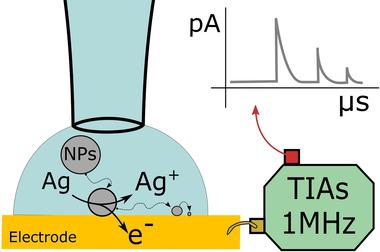当前位置:
X-MOL 学术
›
ChemElectroChem
›
论文详情
Our official English website, www.x-mol.net, welcomes your
feedback! (Note: you will need to create a separate account there.)
Microscale Electrochemical Cell on a Custom CMOS Transimpedance Amplifier for High Temporal Resolution Single Entity Electrochemistry**
ChemElectroChem ( IF 3.5 ) Pub Date : 2020-09-27 , DOI: 10.1002/celc.202001083 Marc Brunet Cabré 1 , Denis Djekic 2 , Timothée Romano 1 , Nadim Hanna 2 , Jens Anders 2 , Kim McKelvey 3
ChemElectroChem ( IF 3.5 ) Pub Date : 2020-09-27 , DOI: 10.1002/celc.202001083 Marc Brunet Cabré 1 , Denis Djekic 2 , Timothée Romano 1 , Nadim Hanna 2 , Jens Anders 2 , Kim McKelvey 3
Affiliation

|
Stochastic collision electrochemistry requires high‐resolution and high‐bandwidth current amplification due to the low magnitude and short duration of the current signals. However, increasing the current amplifier bandwidth leads to increased current noise levels, which in turn obscures the current signal generated from stochastic collision electrochemistry experiments. The key to minimizing current noise is an experimental configuration that minimizes the input capacitance to the current amplifier. Here, we report a new strategy to minimize the input capacitance to a current amplifier by using a movable microscale electrochemical cell, formed at the end of a micropipette using a scanning electrochemical cell microscopy approach, to conduct electrochemical experiments in close proximity (∼300 μm) to a transimpedance amplifier. We demonstrated this via electro‐oxidation of single Ag nanoparticles detected at a bandwidth of 1 MHz.
中文翻译:

定制的CMOS跨阻放大器上的微型电化学电池,用于高时间分辨率单实体电化学
由于电流信号的幅度小且持续时间短,随机碰撞电化学需要高分辨率和高带宽电流放大。但是,增加电流放大器的带宽会导致电流噪声水平的增加,从而又掩盖了随机碰撞电化学实验产生的电流信号。最小化电流噪声的关键是一种实验配置,该配置可以最小化电流放大器的输入电容。在这里,我们报告了一种新的策略,该策略通过使用可移动的微型电化学池(通过使用扫描电化学池显微镜方法在微量移液器的末端形成)来最小化电流放大器的输入电容,以进行近距离(〜300μm)的电化学实验)到跨阻放大器。
更新日期:2020-12-01
中文翻译:

定制的CMOS跨阻放大器上的微型电化学电池,用于高时间分辨率单实体电化学
由于电流信号的幅度小且持续时间短,随机碰撞电化学需要高分辨率和高带宽电流放大。但是,增加电流放大器的带宽会导致电流噪声水平的增加,从而又掩盖了随机碰撞电化学实验产生的电流信号。最小化电流噪声的关键是一种实验配置,该配置可以最小化电流放大器的输入电容。在这里,我们报告了一种新的策略,该策略通过使用可移动的微型电化学池(通过使用扫描电化学池显微镜方法在微量移液器的末端形成)来最小化电流放大器的输入电容,以进行近距离(〜300μm)的电化学实验)到跨阻放大器。











































 京公网安备 11010802027423号
京公网安备 11010802027423号